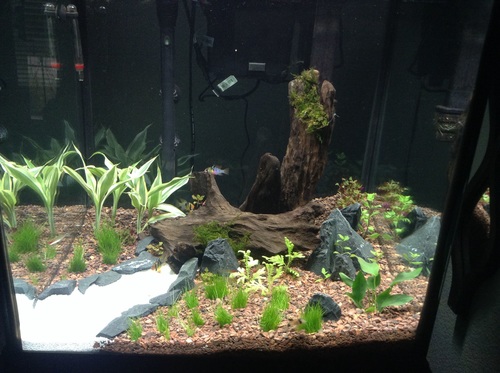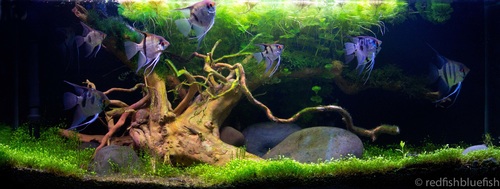STEP-BY-STEP GUIDE FOR SETTING UP A PLANTED TANK

Updated
Cultivating a thriving planted tank can be quite a challenge and if you do not follow the proper procedure, you may not be successful.
When it comes to cultivating a thriving freshwater aquarium, many hobbyists like the look of a planted tank. There is just something about an aquarium filled with beautiful green plants that enhances the overall appearance of the tank. Unfortunately, many aquarium hobbyists do not realize the work that goes into cultivating a successful planted tank. Live aquarium plants require a delicate balance of nutrients as well as adequate lighting in order to grow and thrive – if you do not provide for the needs of your plants, they will end up dying and you won’t have the beautiful planted tank you desire.
Though you have the freedom to arrange your planted tank in any way you like, there is a right and a wrong way to go about setting up the tank. In this article you will receive tips for planning your planted tank as well as a step-by-step guide for setting it up.
Top Nutrients Required for a Planted Tank
Before you set up your planted tank, it may help for you to learn about the nutrients that your plants will require in order to grow and thrive. Having this information in mind will help to make the process of selecting the right substrate and water chemistry for your tank make more sense. The most important nutrients for live aquarium plants are as follows:
- Nitrogen – This macronutrient is essential for the formation of protein, amino acids, and DNA – it also plays a role in nutrient uptake. Deficiencies of nitrogen may cause stunted growth.
- Potassium – This nutrienet helps live plants to break down carbohydrates in order to produce the protein needed to produce fruit and seeds.
- Calcium – This nutrient is needed in certain amounts to prevent stress. If calcium levels are too high, it can interfere with phosphorus levels and lead to various health problems.
- Phosphorus – This nutrient is used for energy storage and the transport of energy. Phosphorus, along with nitrogen, are the most important nutrients for plants – deficiencies may result in stunted growth.
- Iron – This nutrient plays a key role in photosynthesis and it helps with the formation of new chlorophyll molecules. Deficiencies in iron leads to yellowing of the leaves, stress, and eventual death of the plant.
- Zinc – This nutrient is an enzyme activator that is necessary for the formation of leaves. Excess zinc can be dangerous and deficiencies result in “little leaf” syndrome.
- Copper – This nutrient also acts as an enzyme activator. Excess copper can result in inhibited root growth.
Other nutrients that are essential for the health and maintenance of a planted tank include chlorine, boron, magnesium, manganese, molybdenum, nickel, carbon, hydrogen, and oxygen.

Choosing an Aquarium Substrate
Now that you understand which nutrients are most essential for the health and growth of your live plants you will be better equipped to choose the right substrate for your tank. Substrate not only provides your plants with a rooting medium, but it also supplies them with the nutrients they need to grow and thrive. Live plants will not live long if you root them in gravel or sand without adding a layer of nutrient-dense substrate below. Some of the most popular planted tank substrates are listed below:
- Fluorite – This type of substrate is a kind of clay gravel – not only is it lightweight but it does not compact as easily as other substrates. Fluorite can easily be mixed with sand or gravel to create a natural look in your aquarium and it never needs to be replaced. This type of substrate can be used at a rate of 1 pound per gallon in your aquarium and you need to rinse it very well before using it to get rid of the dust.
- Eco-Complete – This is one of the most high-quality options available in planted tank substrate. Not only does it provide more than 25 essential nutrients for your plants, but it also adds live beneficial bacteria to your tank to help get the nitrogen cycle started. Eco-complete comes in several different colors and it is formulated to provide all the nutrients your live plants need.
- Aqua Soil – This type of substrate has a very natural appearance which makes it popular for planted tanks. Aqua soil can be used as the sole substrate in your tank or it can be paired with a base layer of sand to provide biological filtration. This substrate comes in a variety of different colors and it provides long-lasting nutrition for plants.
- Potting Soil – It may sound strange to use regular potting soil in an aquarium, but it can be done. This type of soil requires very little fertilization but it can be tricky to use. You need to be very careful about how you add the soil to make sure it stays submerged.
- Gravel – If you plan to use gravel as the substrate in your planted tank, you need to utilize some type of fertilizer to provide your plants with nutrients. The best type of gravel for planted tanks is small gravel that enables for plant root growth – you can easily use root tabs to fertilize individual plants with this type of substrate.
Having learned the basics about some of the best options for planted tank substrates, you should now be able to decide which one is the right option for your tank. After choosing your substrate you can move on to setting up your tank.

Step-by-Step Planted Tank Setup Guide
Making the decisions about your tank size and the type of substrate you want to use can be a challenge but, once you make those decisions, all you have to do is set up and maintain the tank. Below you will find a step-by-step guide for setting up your planted tank:
- Set up your aquarium stand or cabinet in the desired location for your tank – make sure to place it well away from drafty doors and windows as well as heating/cooling vents.
- Place your aquarium on the cabinet or stand and make sure that it is level – if the stand is not sturdy, your tank could tip over as you fill it with water.
- Rinse your chosen substrate very well until the water runs clear – follow the directions on the package for this as some substrates will not require rinsing.
- Line the bottom of your tank with the recommended amount of substrate – you should have a layer of at least several inches to accommodate the roots of most aquarium plants.
- Fill your aquarium with dechlorinated water then set up and turn on both your aquarium filtration system and your aquarium heater.
- Use an aquarium water test kit to test the water chemistry in your tank – the ideal pH for a planted tank that includes both fish and plants is between 6.5 and 7.5.
- Install your lighting system and make sure that it provides enough lighting for your plants – a heavily planted tank will require about 3 to 5 watts of light per gallon.
- Add your aquarium plants and bury the roots deep into the substrate for stability and to ensure that they receive adequate nutrition.
- For the best results, place the taller plants at the back and sides of your aquarium and shorter plants in front – this will create a natural appearance while also ensuring that your fish have plenty of swimming space in the center of the tank.
- Incorporate additional decorations like rocks and pieces of driftwood to enhance the appearance of your tank.
- Let your aquarium run for a full two to three weeks in order for the nitrogen cycle to become established – your plants will help this process along.
- Test your aquarium water again – if the ammonia level reads zero, your tank is ready for fish.
- Acclimate your fish slowly to the tank to avoid shocking them with a change in water temperature or water chemistry.
Once your fish have been introduced to the tank, all you have to do is maintain it! You should monitor the water chemistry in your tank by testing it at least once a week – this will help you to keep track of ammonia levels to make sure that your live plants and your beneficial bacteria are doing their jobs. With adequate nutrition and lighting, your planted tank should thrive.
comments powered by Disqus






































































































































